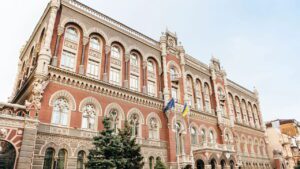
Net sales of dollars by the National Bank of Ukraine rose to $737.8 million last week compared to $510.7 million a week earlier and $475.0 million two weeks earlier.
According to the information of the National Bank on its website, from September 19 to 23, it purchased $7.1 million, which corresponds to the usual purchase volumes during the war, while it sold $744.9 million compared to $528.2 million a week earlier.
This week, on the cash market, the hryvnia again weakened by about 70 kopecks, and its rate came close to the level of UAH 43/$1, while the official rate of UAH 36.57/$1 was fixed since July 21, but by the end of the week it strengthened to UAH 42.7/$1. $1.
Since the beginning of September, the volume of interventions of the National Bank in the market has already exceeded $1.8 billion compared to $1.33 billion in August and $1.2 billion in July, but still remains much less than in June ($3.96 billion) and May ( $3.4 billion).
Finance Minister Sergei Marchenko said that in August the volume of foreign aid to Ukraine amounted to a record $4.6 billion since the beginning of the war, compared with $1.7 billion in July and $4.4 billion in June.
In general, from the beginning of the year to September 23 inclusive, the NBU purchased $3 billion 121.3 million and EUR111.0 million on the market, and sold $18 billion 607.7 million and EUR1 billion 789.1 million.
Including since the beginning of the war, the purchase of foreign currency has reached $2 billion 464.4 million and EUR111.0 million, and the sale – $15 billion 837.5 million and EUR1 billion 789.1 million.
The international reserves of Ukraine as of September 1, 2022, according to the NBU, amounted to $25.436 billion (in equivalent), which is 13.6% or $2.679 billion more than at the beginning of August. In July, the fall in reserves amounted to 1.6%, or $371.5 million, in June – 9.3%, or $2 billion 343.8 million.

The National Bank of Ukraine is discussing the issue of a possible entry into the secondary market with its portfolio of domestic government bonds, as this may be one of the elements of strengthening monetary transmission and sterilizing excess hryvnia liquidity, NBU deputy head Serhiy Nikolaychuk said.
“In addition, this step will reduce the negative impact of the issue. We are working on technical issues and consulting with our stakeholders,” he said in an interview with Delo.
Commenting on the opinion that the National Bank’s entry into the market with its bonds may reduce the effectiveness of the primary auctions of the Ministry of Finance, Nikolaychuk noted that the reason for the low results of these auctions lies in the low rates offered to buyers, which was confirmed by insignificant volumes of attraction even before the resumption of the secondary government bonds market in early August.
“In order for the auctions of the Ministry of Finance to be successful, it should move towards the government bonds yield that the market wants to see. The NBU, in the event of an exit with its portfolio of government bonds, will focus primarily on the market yield of government bonds. Otherwise, such a step would make no sense” – said the deputy head of the NBU.
According to him, now for the most liquid hryvnia government bonds with a circulation period of 6-12 months, rates in the secondary market have stabilized at the level of 20-25% per annum, while the Ministry of Finance offers 12-14%.
Speaking about the situation in the foreign exchange market, Nikolaychuk pointed out that today the balance of supply and demand in the foreign exchange market of the National Bank “is more or less satisfactory.”
“And according to our estimates, it should not worsen during September and October. We also expect that, thanks to international assistance, we will be able to keep gold and foreign exchange reserves at a sufficient level,” the deputy head of the NBU said.
Currently, the total value of government bonds in the portfolio of the National Bank in terms of the principal debt is UAH 619.5 billion, while the total government bonds in circulation are worth UAH 1 trillion 280.9 billion, and the portfolio of banks is UAH 497.2 billion, non-residents – 66.9 billion UAH, legal entities – UAH 65.8 billion and individuals – UAH 30.8 billion.

The leader in increasing the volume of public deposits in June was the state-owned PrivatBank, which increased them by UAH 21.08 billion, or 6.6%, over the month.
As reported on the website of the National Bank of Ukraine (NBU), another representative of the state, Oshchadbank, follows: the absolute inflow of public funds to it amounted to UAH 5.74 billion, and the relative inflow was 4.2%.
At the same time, if at Privat the number of depositors increased by 68.03 thousand, including currency depositors – by 35.98 thousand, then at Oshchad the number of depositors decreased by 30.5 thousand. with an increase in currency by 2.8 thousand
The largest increase in the number of depositors in June was shown by the Ukrainian Universal Bank (monobank) – 114.91 thousand, including currency depositors – 48.15 thousand. With such an increase in depositors, the increase in deposits amounted to 2.6%, or UAH 1.16 billion, which ensured the bank the fourth position.
Banks with foreign capital – Ukrsibbank and Raiffeisenbank, in which 40% and 30% respectively belong to the European Bank for Reconstruction and Development (EBRD), took third and fifth place. Deposits in them increased in June by UAH 1.59 billion, or 3.8%, and by UAH 1.09 billion, or 2%, respectively, and the number of depositors increased by 20.6 thousand. and 10.1 thousand
On the other side of the list is Alfa-Bank, deposits in which in June decreased by UAH 943.5 million, or 2.2%, including currency deposits – by UAH 699.5 million, or 3.4%. At the same time, the number of depositors increased by 13,140, which is probably due to the bank’s card product and a good exchange rate for it.
In addition, UAH 386.7 million, or 1% of the funds of natural persons, was left in June by FUIB. He also had the largest part of the outflow – UAH 224.7 million – on currency deposits.
The outflow of funds from Accordbank amounted to UAH 124.3 million, or 6.8%, from Vostok Bank – UAH 103.7 million, or 2%.
Rounding out the bottom five is A-Bank, whose deposit volume in June decreased by UAH 74.7 million, or by 0.8%. At the same time, the increase in depositors was 59.08 thousand. – it came third, second only to monobank and PrivatBank, and far ahead of the trailing TASkombank with 22.68 thousand. new depositors.
In general, according to the data of the NBU, in June the funds of individuals in banks increased by UAH 30.36 billion, or by 3.5% – almost all due to hryvnia deposits, since currency deposits increased by only UAH 0.17 billion, or by 0 ,1%.
Data on the volume of deposits and the number of individual depositors in Ukrainian banks as of 07/1/22 and their dynamics in June (Ukrainian)

The National Bank of Ukraine (NBU) has canceled the licenses of FC Constanta M, DSD Finance, 24 Online and Financial Guarantee, which cover 15% of the currency exchange market, for violating the requirements of currency legislation, the press service of the regulator said on Friday.
According to the report, the central bank also fined Finovis and 24 Online companies UAH 151,000 each for violating money laundering laws.
It is indicated that as of August 4, the NBU conducted 40 inspections of structural units of 15 non-banking financial institutions.
These decisions were made at a meeting of the Committee on Supervision and Regulation of the Markets of Non-Banking Financial Institutions on August 5.

The National Bank of Ukraine (NBU) expects a reduction in international reserves in the second half of the year by 8.6% – from $22.8 billion to $20.8 billion and maintaining them at this level in 2023, the regulator’s forecast says.
According to him, at the end of 2023, the reserves will amount to $21.2 billion, and in 2024 they will grow to $28.7 billion.
At the same time, the current account balance, according to the regulator’s forecasts, will be positive and amount to $6.4 billion by the end of 2022, while at the end of last year it was negative and amounted to $3.2 billion.
The NBU expects that by the end of 2023 and 2024 this figure will be negative and amount to $3.9 billion and $8.8 billion, respectively.

From 09:00 on July 21, 2022, the National Bank of Ukraine adjusted the official exchange rate of the hryvnia against the US dollar by 25% – from UAH 29.2549/$1 to UAH 36.5686/$1, taking into account changes in the fundamental characteristics of the Ukrainian economy during the war and strengthening of the US dollar against other currencies, according to a message on the NBU website.
“Such a step will increase the competitiveness of Ukrainian producers, bring together the exchange rate conditions for different business groups and the population and maintain the stability of the economy in a war,” the National Bank said.
He stressed that the official exchange rate of the hryvnia against the US dollar continues to be fixed.
“With the high uncertainty caused by the war, a fixed official exchange rate against the US dollar is the main anchor for stabilizing expectations and a key means of achieving the NBU’s priority goals. They are to ensure price and financial stability, which is an important condition for economic recovery,” the regulator explains its position.